The mid-Atlantic region of the U.S. has a rich diversity of native plants appropriate for use in the residential landscape. In fact, some of the stalwarts of the landscape industry are native to this region. There are four distinct seasons, and we are fortunate to have good amounts of average annual rainfall, but we are also subject to occasional drought. Native species, when established in soils that are appropriate to their nature, can handle these natural fluctuations in weather without being damaged severely.
In selecting these 10 shrubs, I looked for plants that would grow well in residential landscapes, fit into most residential designs and require relatively low maintenance. The list includes several evergreens, as well as early- and late-season bloomers. As such, a combination of these plants can be used to provide year round-interest in the garden. As mid-Atlantic natives, these plants contribute to a sense of place — the landscape looks like it belongs to and celebrates local character. Another important factor is whether each shrub contributes to the local ecology. Does it provide food or shelter for birds and pollinators? Most of these plants can be found for sale, some as wild types and many as cultivars, or in this case “nativars.”
Because the list is limited to 10, many favorites were left out. But I hope these plants can be used as a starting point in building a successful mid-Atlantic landscape.
Not in the mid-Atlantic? Browse plants native to other regions of the U.S.
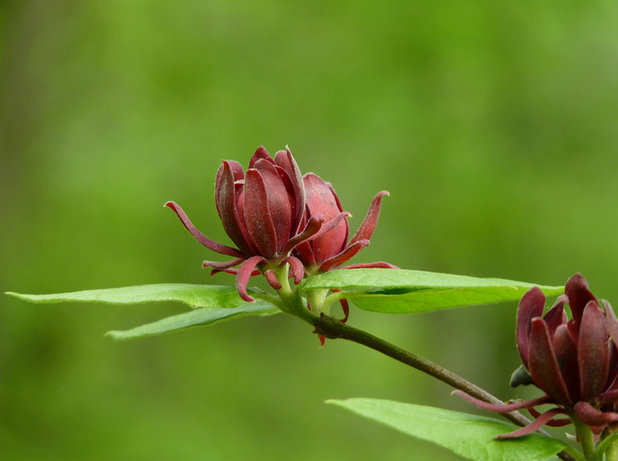 Eastern Sweetshrub
Eastern Sweetshrub(
Calycanthus floridus)
Native from southern New York state to northern Florida and west to Arkansas and Illinois
This dense, mounding deciduous shrub grows to 6 to 9 feet tall and 6 to 12 feet across. Its native habitat is deciduous woodlands and bottomlands. It tolerates full sun to shade and a wide variety of soils. It is usually more compact in sunnier locations.
In midspring it bears unusual cup-shaped red flowers that fill the air with a fruity, sweet scent. The twigs and foliage have a pleasant spicy scent when disturbed. When not in bloom, the large, lustrous leaves form a good background for other garden plants. Note that seed-grown plants are variable and may not have the same fruity scent as the cultivated varieties.
See how to grow eastern sweetshrub

Austin Ganim Landscape Design, LLC
Coastal Sweet Pepperbush (
Clethra alnifolia)
Native along the East Coast from southern Maine to the southeastern corner of Texas
This versatile shrub likes moist, organic, somewhat acidic soil in partial to full sun. In the garden, it will tolerate average moisture conditions. It is found growing within a hundred miles of the ocean along the eastern United States. Blooming in midsummer, it provides a burst of sweetly scented white flowers after most other shrubs are done for the season. Bees and wasps are drawn to these flowers, generally ignoring the presence of humans. If there is an issue, these plants should be sited away from seating and eating areas.
The straight species grows to 9 feet tall and 12 feet wide. It is a suckering shrub and will spread out wider with time. There are several dwarf varieties that grow to less than 4 feet tall, including ‘Sixteen Candles’ and ‘Hummingbird’. There are also pink-flowering forms — for example, ‘Ruby Spice’, which grows about 6 feet tall.
Sweet pepperbush leafs out later than most shrubs, so don’t prune off the dead-looking branches until the leaf buds open up in midspring. It blooms on new wood, so spring pruning will not remove any preformed flower buds. It is resistant to salt spray, and deer tend to leave it alone.
See how to grow coastal sweet pepperbush
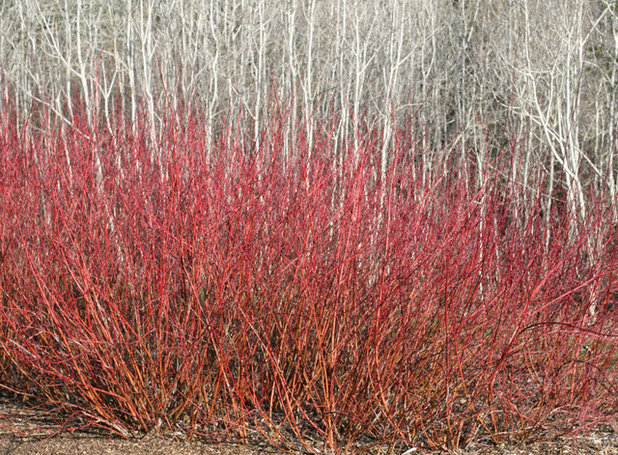
Tom Debley
Redtwig Dogwood(
Cornus sericea)
Native to Canada and the northern U.S. from Maine to Washington and south to West Virginia and parts of New Mexico and Arizona
Redtwig dogwood, also called redosier dogwood, is found in swamps, along stream banks and in thickets in full sun to partial shade. It will also tolerate drier upland conditions. It does not do well in the warmer, more humid conditions beyond USDA Zone 7 (find your zone). Left alone, this shrub will grow 7 to 9 feet tall and spread by underground stems.
This shrub features a long blooming period beginning in midspring and lasting into summer. The flat-topped clusters of small white flowers are followed by good-size white berries that birds love. As the weather cools, deep red stems develop that add interest throughout the winter.
The best stem color appears on the one- to two-year-old branches. For best color, branches more than two to three years old should be pruned off. With this pruning, the shrub will rarely reach its full size in the garden. Planting a mass of these in front of evergreens, or some other plain background, will show off the winter color the best.
This shrub is tolerant of alkaline soils. Some protection from deer browsing may be needed, though my plants usually bounce back quickly.
See how to grow redtwig dogwood
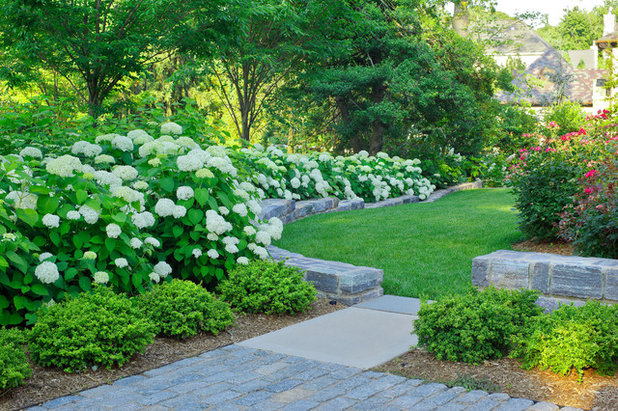
Katia Goffin Gardens
Wild Hydrangea(
Hydrangea arborescens)
Native from southern New York to northern Florida and as far west as eastern Oklahoma
The natural habitats of wild hydrangea, also known as smooth hydrangea, include rich forests and stream banks. It likes partial sun to shade and moist conditions. It can tolerate full sun given sufficient moisture, and in average soils it prefers some shade.
This species of hydrangea blooms on new wood, so blooming is not affected by the winter cold that plays havoc with many of the introduced large-leaf hydrangeas (
H. macrophylla). In fact, by pruning wild hydrangea close to the ground, down to between 1 inch to 6 inches, in the fall, or before growth begins in early spring, you can get a good crop of flowers on 3- to 4-foot-tall plants. It is a good idea to provide some extra support, with cages or strings, to reduce flopping of the heavy flowers when they get wet. A second flush of flowers in late summer can be produced if the first set is removed by early July.
Wild hydrangea in the garden is most often the ‘Annabelle’ cultivar or something similar. This cultivar features large domes of white flowers from late June through summer.
The flower heads can be dried, by removing the leaves from spent blooms and hanging the flower heads upside down for several weeks. These are effective in indoor arrangements.
Wild hydrangea tolerates alkaline conditions, making it a good foundation plant. Under good conditions it spreads by stolons and will fill an area in a couple of seasons. Wild-type plants have smaller and more variable-size flower heads. Deer will browse on the flowers and foliage, so some deterrence may be needed.
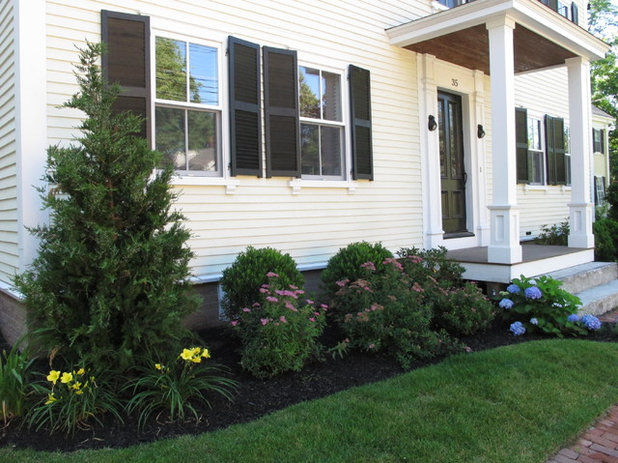
Nilsen Landscape Design, LLC
Two young inkberry bushes are planted under the windows. If they are one of the compact cultivars, they can be kept below the bottoms of the window frames with minimal pruning. Also in this photo is a cultivar of eastern redcedar (Juniperus virginiana) on the corner and a small-leaf form of mountain laurel (Kalmia latifolia) next to the porch.
Inkberry (
Ilex glabra)
Native to the coastal regions from as far north as Maine south to Louisiana
Inkberry grows well in moist to moderately dry, acidic soils in partial sun to shade. It will grow in full sun but needs sufficient moisture. Native habitats include woody swamps, low woods and thickets in coastal areas. Inkberry is deer- and salt-resistant.
This small- to medium-size evergreen shrub has glossy dark green ovate leaves, typically 1 inch to 2 inches long. It makes a good hedge or background plant. Plants generally grow 4 to 10 feet tall with a similar spread. While not visually exciting, inkberry produces dark, nearly black berries in the fall. While poisonous to humans, birds enjoy them. Like other hollies, male and female flowers are carried on separate plants, so one of each is required to get berries.
Inkberry takes pruning well. The removal of winter-damaged branches quickly results in new growth. Many of its cultivars are compact for use as a hedge. Larger plants have a more natural form that can be enhanced with careful pruning to show off the branch structure.
There are a number of commercially available cultivars with different sizes, leaf colors, genders and berry colors. One cultivar that is currently very popular is ‘Shamrock’, which grows 3 to 5 feet tall. It’s a female plant that holds its lower leaves better than the straight species.

Paintbox Garden
Common Winterberry(
Ilex verticillata)
Native from New Brunswick, Canada, to northern Florida and westward to Louisiana and Minnesota
This holly likes full sun to light shade in moist to wet soils, but it is adaptable to average soils. Its natural habitats include swamps, wet woodlands and thickets.
Common winterberry grows as a multitrunked shrub, or it can be trained to a single trunk into a small tree. It typically grows 6 to 10 feet tall and wide. A good pruning job will show off some of the nice branching in the crown. Winterberry produces small white flowers around early June in the mid-Atlantic region. The bright red berries produced in early fall are winterberry’s most exciting feature, lasting through much of the winter. Winterberry also has pretty burgundy fall foliage.
This shrub is an important food source for overwintering birds. Fortunately, the nursery industry provides distinct male and female cultivars of winterberry so that you can be assured of berry production. In general, a single male plant is sufficient to fertilize five female plants within 100 feet.
Bloom times vary by a couple of weeks depending on whether the cultivar comes from the northern or southern part of the range. For northern cultivars, ‘Jim Dandy’ is a good choice for a male. In the South, ‘Southern Gentleman’ is the cultivar of choice.
See how to grow common winterberry
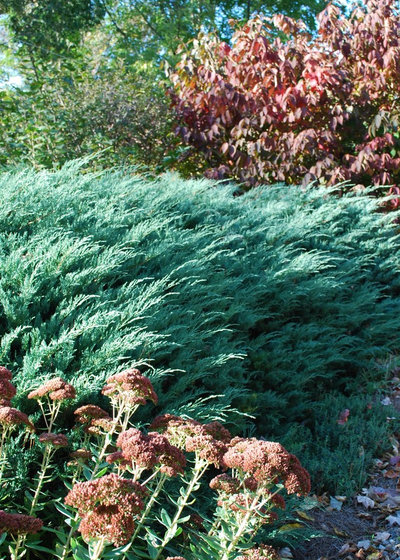
Jay Sifford Garden Design
The lower-growing ‘Grey Owl’ eastern redcedar cultivar is seen growing between ‘Shasta’ viburnum (Viburnum ‘Shasta’) and ‘Autumn Joy’ sedum (Sedum ‘Autumn Joy’).Eastern Redcedar(
Juniperus virginiana)
Native from southern Maine to northern Florida and westward to Texas and South Dakota
Eastern redcedar grows well in full to partial sun with a range of soil moistures from moist to dry. It can be found growing in diverse habitats, from balds, roadsides and old fields to swamps. It is a common sight in abandoned fields. It is tolerant of alkaline soils, making it a good choice for a foundation plant.
In its natural form, eastern redcedar is considered a tree, growing 40 to 50 feet tall with a spread of 8 to 20 feet. However, most of the forms you find in the nursery are more shrub-like. These evergreens have scale-like leaves rather than the needles found on most other conifers.
Redcedar provides year-round cover for birds and other small animals. This shrub also produces berry-like cones in a range of colors that many birds eat. To get a crop of berries, you need both male and female plants. This may not be too critical since redcedars are so widely distributed.
Noteworthy shrub forms include ‘Grey Owl’, a prolific female growing 3 feet tall and 6 feet wide with silvery foliage. ‘Globosa’ has a rounded form with emerald green foliage, growing slowly to 15 feet tall. ‘Burkii’ is a male plant with an upright form and blue-green foliage, growing 10 to 15 feet tall and half as wide. ‘Emerald Sentinel’ is a female that grows to 25 feet tall and only 8 feet wide, with dark green foliage and lots of cones. When selecting a cultivar, consider the mature size to save yourself a lot of time spent pruning down the line.
If you are growing apple or crab apple trees, you may not want to add any of these cedars nearby. Junipers are an alternate host for cedar-apple rust, a fungal infection that moves from junipers to apples and back again. While it does not significantly harm the cedar, it can defoliate apple trees.
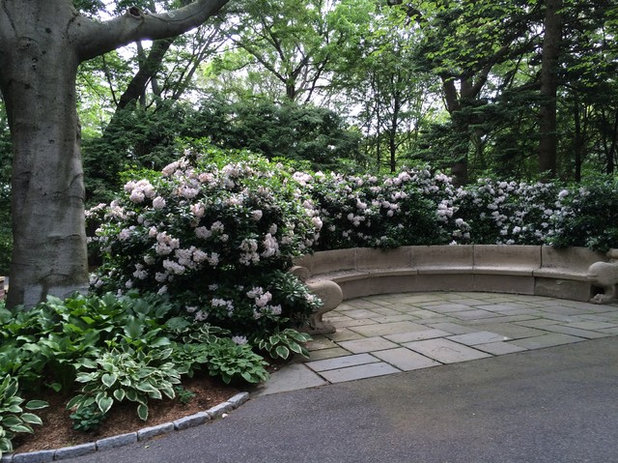
Garden Gallery LLC
The flowering mountain laurels shown here are in open shade, an ideal environment.Mountain Laurel(
Kalmia latifolia)
Native from Maine to Mississippi and southern Indiana
The natural habitats of mountain laurel include rocky woodlands and cliffs as well as old fields, meadows and swamps. It grows best in moist soils but will tolerate some dryness. It prefers partial sun, but it can handle more sun if consistent moisture is provided. It requires acidic soil for healthy growth. Though deer don’t favor it, they may browse on the foliage in late winter when there is nothing else to feed on.
Caution: All parts of mountain laurel are toxic to humans.
This mounded evergreen shrub has oblong leathery leaves that grow in whorls around the stems. Fragrant blooms appear as flat-topped clusters in early June. Individual buds and blooms consist of tightly packed pentagons — a striking study in geometry. The color of the cup-shaped flowers ranges from white to dark pink, often with distinct stripes or spots. Mountain laurel’s size ranges from 4 to 15 feet tall and 4 to 8 feet across, depending on the individual plant and the growing conditions.
There are a large number of named cultivars, each with distinctive flower markings or sizes. For more compact plants there is a small-leafed form (
myrtifolia) that is one-third to one-half the size of the typical species. Of these smaller plants, the cultivars ‘Elf’, ‘Little Linda’ and ‘Minuet’ are good performers.
Sometimes mountain laurels can be finicky, and locally sourced plants will do better than ones grown across the country in a different climate.
See how to grow mountain laurel
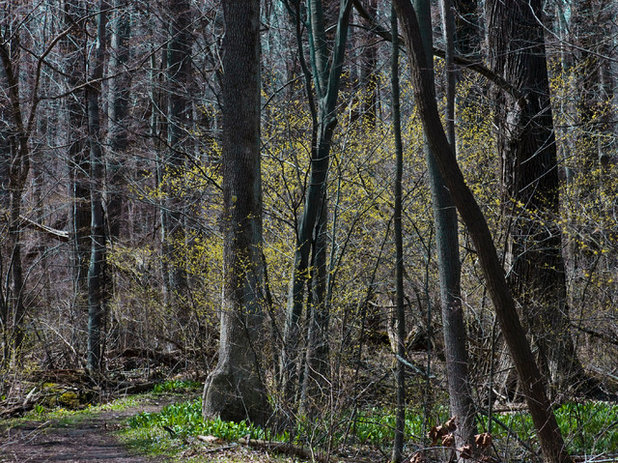
Michael Huft
Spicebush(
Lindera benzoin)
Native from southern Maine to northern Florida and westward to Texas and Missouri
Spicebush grows in moist deciduous woods, and it will even tolerate full shade; it also grows in full sun with sufficient moisture.
This early-season shrub has spicy-scented pale yellow flowers that give way to bright red berries in late summer. The thin pulp around the berries tastes like allspice. These are very popular with the birds, so they seldom last long on the bushes. The leaves and branches also give off a spicy aroma when bruised. Spicebush grows 6 to 12 feet tall and wide.
Both male and female plants are needed to get berry production, but unfortunately, plants for sale are seldom identified by sex.
These are difficult to transplant, but I have had good luck with bare-root plants put in in early spring. Container plants will also work well.
See how to grow spicebush
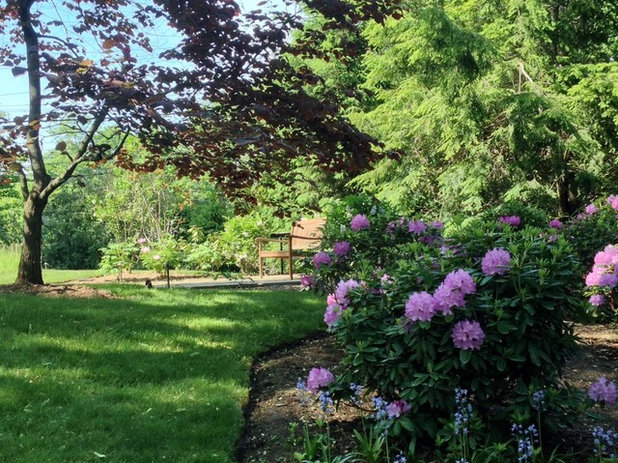
ADRIAN SMITH - Landscape Architecture
Catawba Rosebay(
Rhododendron catawbiense)
Native to the southern Appalachian Mountains from West Virginia and Kentucky to northern Georgia and Alabama
Natural habitats range from balds and mountain slopes to forests and rocky stream banks. These are very shade-tolerant but do not like consistently wet soils. They require acidic soil with a pH of 4.5 to 6.
Rhododendrons take pruning well. Mature plants can be cut back severely and will recover in a season or two. Deer may browse on the foliage in late winter when there is nothing else to feed on.
Caution: All parts of catawba rosebay are toxic to humans.
This beautiful evergreen shrub has large, ovate dark green leaves and is covered with purple flowers in midspring. These plants typically grow 4 to 10 feet tall and 5 to 12 feet wide. They can grow in full sun or shade.
These plants are available mostly as cultivars, with flower colors ranging from white to rose-purple. ‘Roseum Elegans’, ‘Boursault’ and ‘Grandiflorum’ are common cultivars. Catawba rosebay is also used in breeding programs to create many of the commercial hybrid rhododendrons available today.





